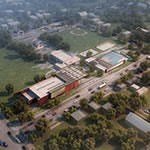In her seminal work, The Death and Life of Great American Cities, Jane Jacobs famously wrote, “You can neither lie to a neighborhood park, nor reason with it.” Parks are so integral to the vitality of the city that, in order to be successful, they must originate and operate organically, and the story of Houston’s 10-acre Emancipation Park is a classic example.
The property was purchased in 1872 by former slaves for $800. It was the first public park in Texas and saw nearly 100 years of organic success until the automobile altered life in Houston and drove the neighborhood into poverty. In 2007, Friends of Emancipation Park raised $33 million to renovate the park, the design of which is led by architect Phil Freelon of the Freelon Group and M2L Associates, who will be responsible for the landscape architecture.

A large steel frame canopy gives form to the “front porch” area to shelter the main entrance.

The old recreation center will be repurposed as a community center, and the pool house will be renovated and expanded.

A ground-source heat pump will conserve energy and help the park’s buildings reach LEED Silver certification. Solar-thermal panels on top of the steel-frame canopy will provide hot water.
The project will refurbish the park’s existing landscapes and playgrounds, renovate the two historic buildings on-site, and add a new building and plaza. The buildings and the interior park program also will be reimagined to introduce a more organic flow to the park, reincorporating the park into the fabric of the neighborhood.

